Semantic Mapping to Grow Vocabulary

Knowledge helps you remember new information, and people who know a great deal about a topic also know its vocabulary. One critical finding from research is that word learning takes place most efficiently when the reader or listener already understands the context well. In fact, we learn words up to four times faster in a familiar context than in an unfamiliar one (Landauer & Dumais, 1997; Hirsch, 2006). Vocabulary instruction that compares and contrasts word meanings and that activates prior knowledge not only helps students learn new words, but also has been shown to improve comprehension of a reading selection (Graves, 2006). Therefore, an important goal of instruction in any subject grade, in any grade, should be to help students acquire the vocabulary associated with the content and to make connections between known and unknown words.
There are four activities that are part of my professional development program titled The Key Vocabulary Routine that are designed to teach words in relation to other words: Semantic Mapping, Categorizing, Semantic Feature Analysis, and Opposites (sometimes called Scaling). This post will provide details for how to use Semantic Mapping (Heimlich & Pittelman, 1986) which is a well-researched activity that helps students draw on background knowledge of a topic and see connections between ideas and words related to that topic. It is highly interactive and offers opportunities for rich, collaborative discussion among students.
There are two steps for generating a semantic map. First, the teacher chooses a key concept word that is central to the topic covered in the reading or classroom lesson and writes this word in the center of a page or on the board. Students are then asked to brainstorm as many words as they know associated with the key word. This brainstorming is best done as a whole class or in smaller cooperative groups. The teacher or a scribe writes the words generated on the board. The visual below is an example of semantic map that was generated in a fifth grade classroom related to text students were reading that had information about baseball.
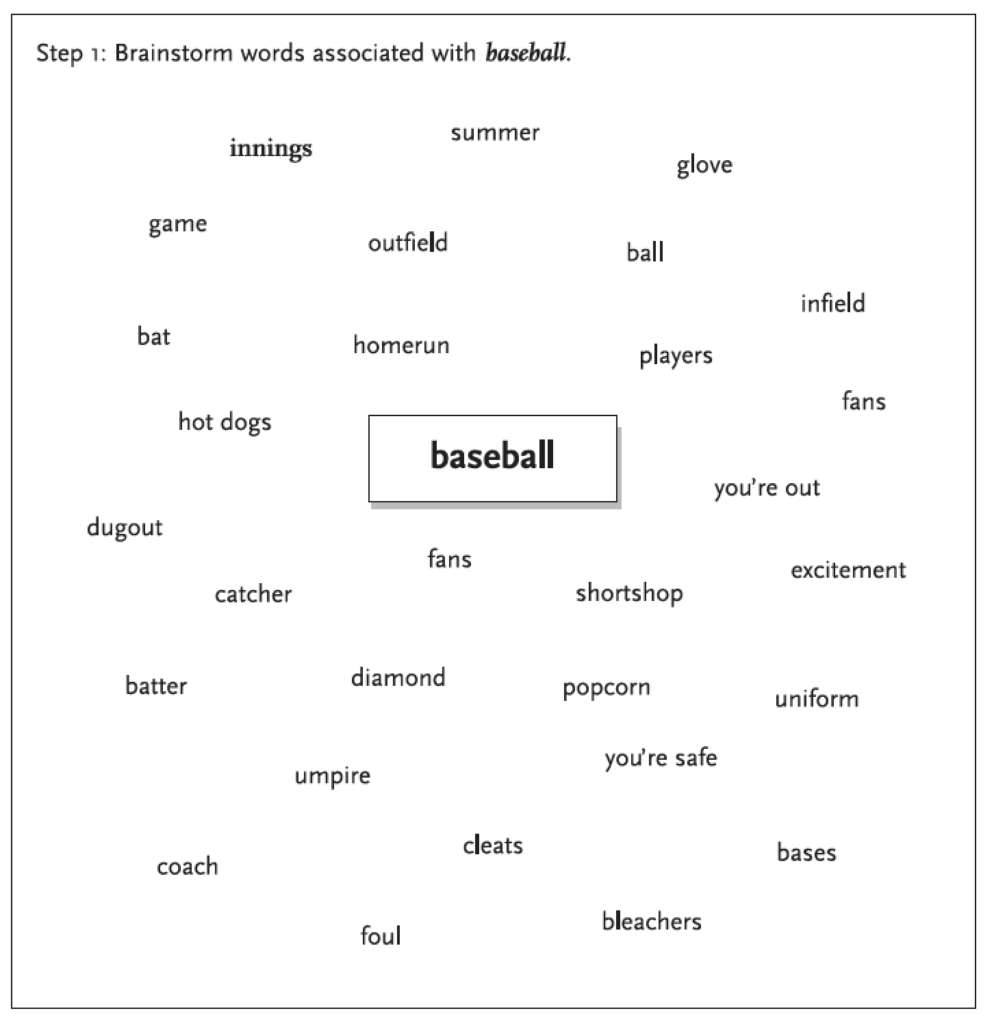
Once a significant number of words has been generated, students are asked to make connections among the words and group them into categories. See the visual below of the categorized baseball words. There is no “right” or “wrong” answer to this task! Sometimes one of the words on the map becomes the word for a category (e.g., uniform), and sometimes a new word needs to be generated for the category (e.g., referee, equipment). Once the categories are identified, students can be asked to add more words to each category. Sometimes there will be words that are not easily grouped into a category (e.g., innings, game, summer, dugout). This is a simple example, but semantic mapping can be used with any grade level, right up through high school, using a sophisticated key content word and more advanced academic vocabulary.
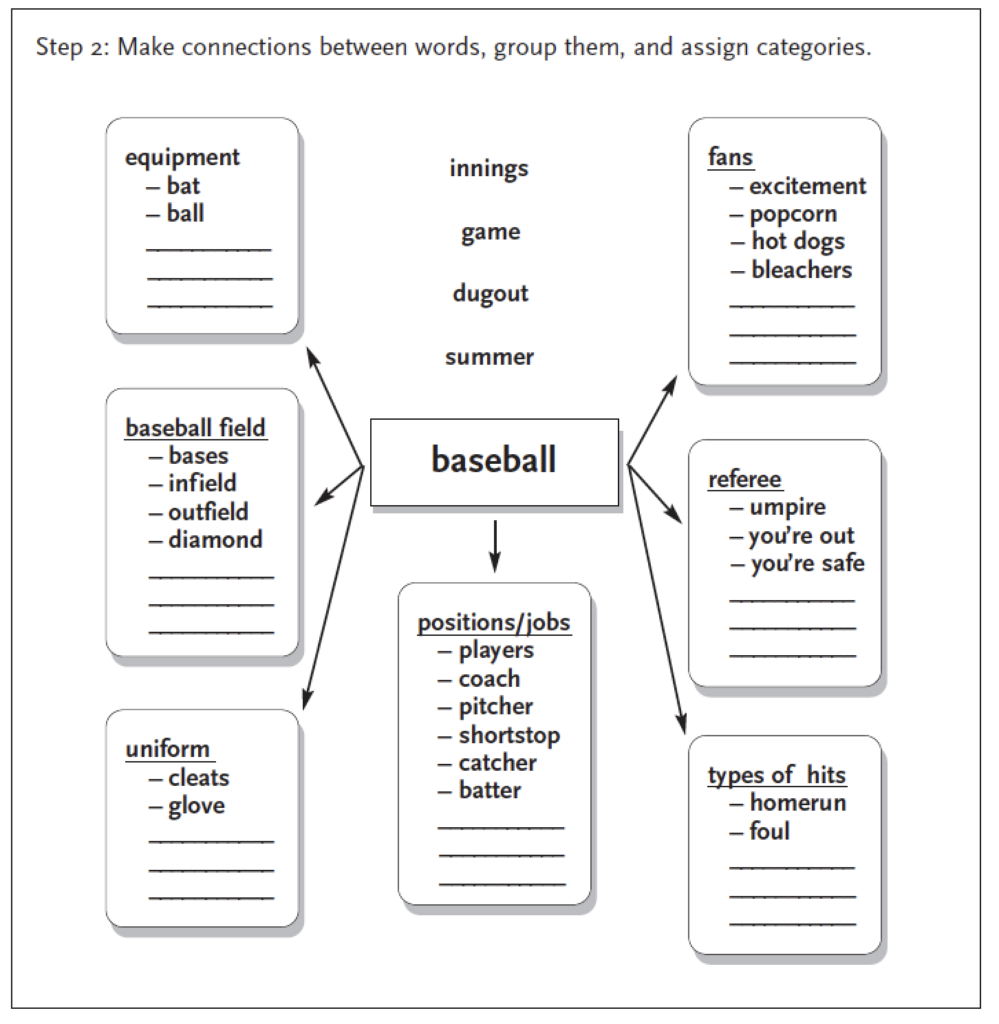
Scaffolds
Sometimes a new concept word will be so foreign to students that they are unable to generate many of their own words. For example, the background information for students growing up in a city may not be sufficient to brainstorm many words related to the word harvest. When this happens, teachers can provide some background knowledge about the topic to get the brainstorm going. Another scaffold is to provide a list of words that includes some that are related to the key word and some that are not. Students consider each word to determine if it should be added to the semantic map. The categorizing part of the activity can also be scaffolded by the teacher providing category topics. If you are working with young children who have not yet developed solid reading and writing skills, you can use a picture in the center of the map instead of a word, an the brainstorming can be done orally with the teacher transcribing the words.
A Before and After Activity
A semantic mapping activity can begin before students read or learn new information as a way to help them access what they already know about a topic. It also serves as a great “after” activity to extend the vocabulary learning. The teacher can bring back the semantic map or the words listed in categories and ask students to add any new words they have learned about the topic. As noted above, one advantages of semantic mapping is that it is a collaborative task that provides lots of opportunities for the students to talk about words and how they are related, using real-life contexts to explain the words they generate. It also is engaging and motivating, and important part of developing a word conscious classroom in which students enjoy learning words!
I’ll end this post by showing several classroom examples of semantic maps. The first one from a grade 2 classroom is interesting because you can see that the words at the top of the map were generated before the students listened to a read aloud about snails. Word such as slow, slimy, small, and slithery are words the students already associated with snails. The words on the bottom of the map were generated after the read aloud. Words such as gastropod, herbivore, and mollusk represent new, academic words that the students learned.
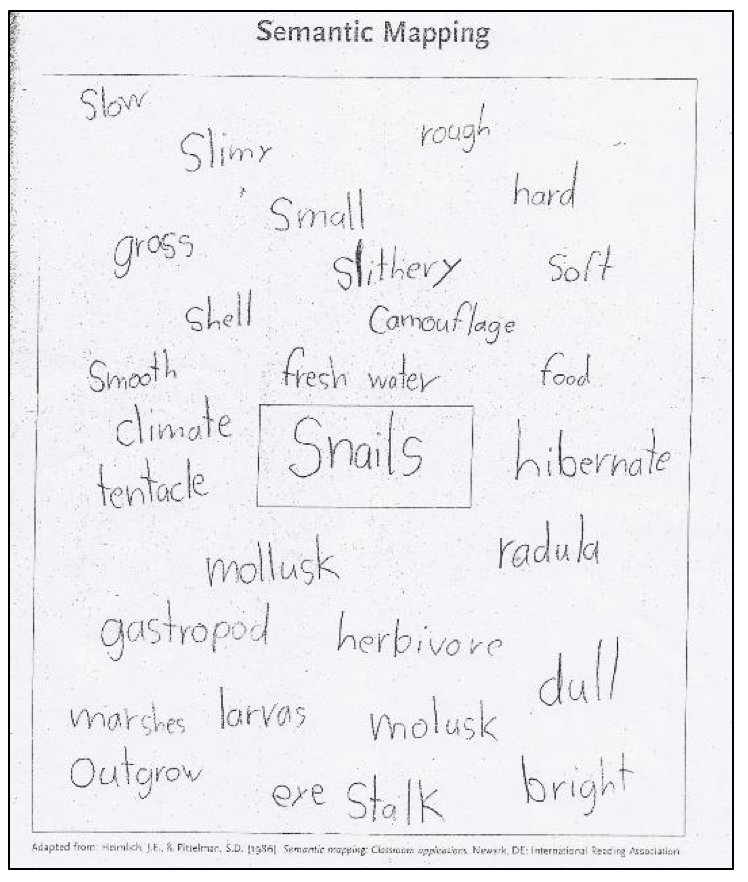
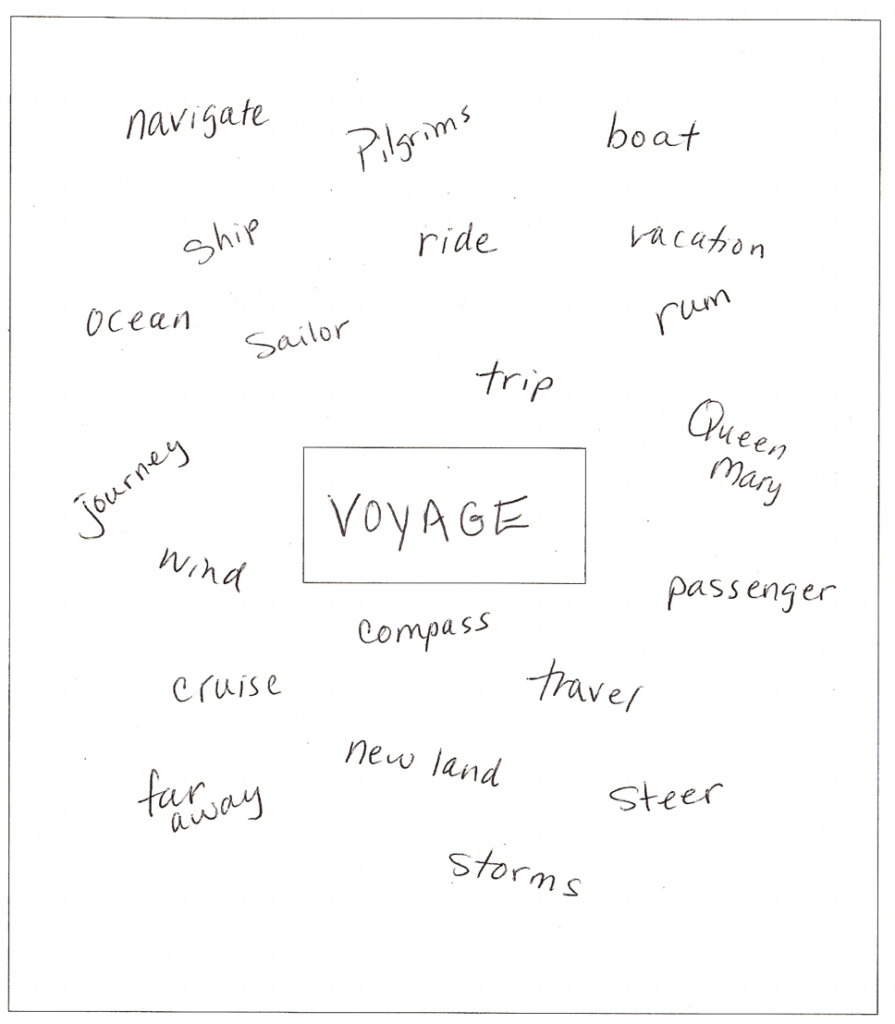

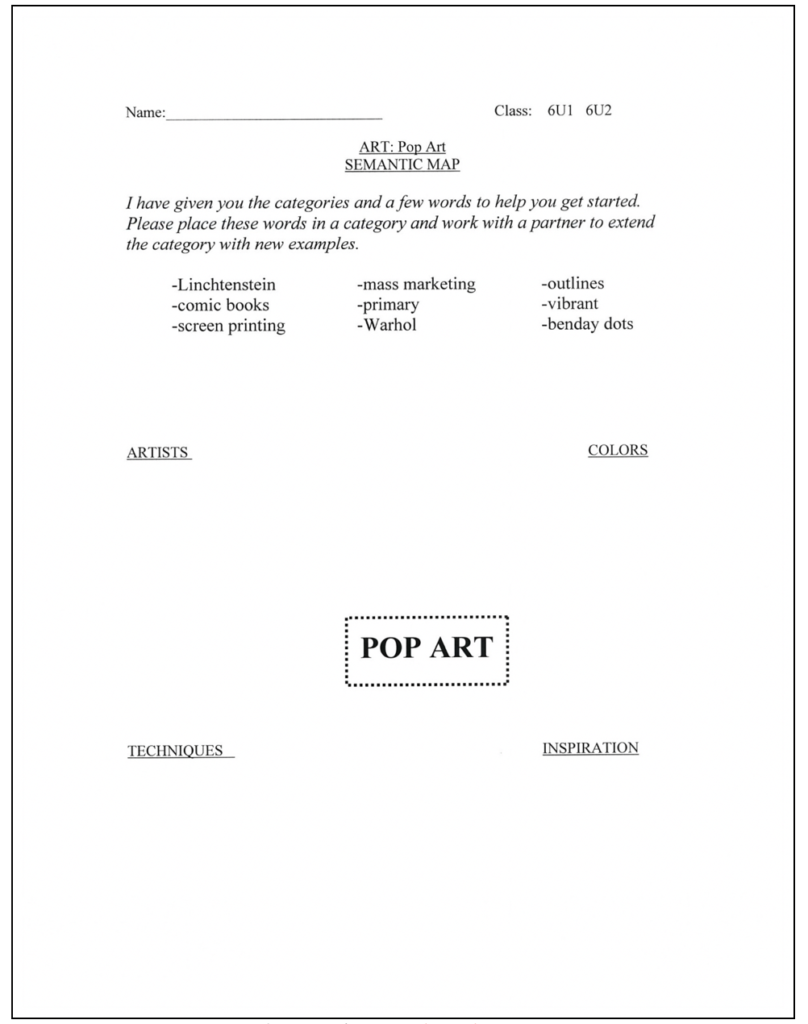
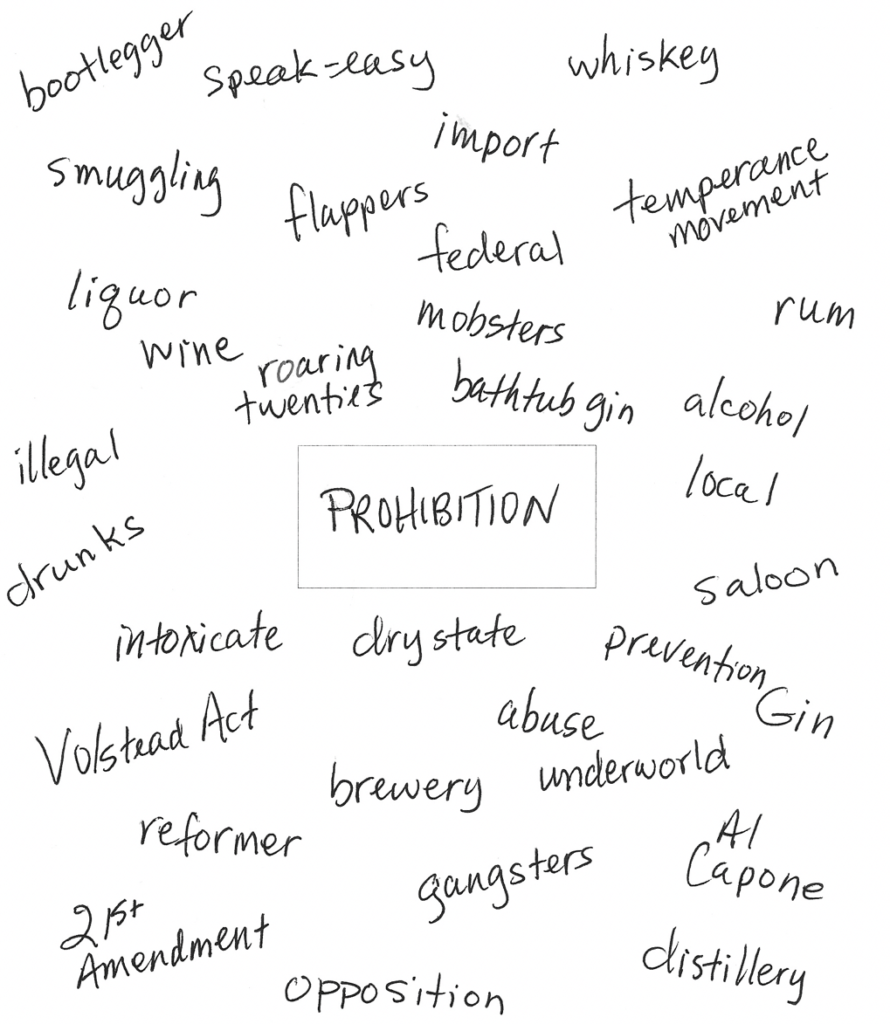
References:
Graves, M.F. 2006. The vocabulary book. New York: Teachers College Press
Heimlich, J.E., & Pittelman, S. D. (1986). Semantic mapping: Classroom applications. Newark, DE: International Reading Association.
Hirsch, E.D. (2006). The case for bringing content into the language arts block and for a knowledge-rich curriculum core for all children. American educator. Spring, 2006.
Landauer, T.K., & Dumais, S. T., (1997). A solution to Plato’s problem” The latent semantic analysis theory of acquisition, induction, and representation of knowledge. Psychological Review, 104 (2).

 Joan Sedita is the founder of Keys to Literacy and author of the Keys to Literacy professional development programs. She is an experienced educator, nationally recognized speaker and teacher trainer. She has worked for over 35 years in the literacy education field and has presented to thousands of teachers and related professionals at schools, colleges, clinics, and professional conferences.
Joan Sedita is the founder of Keys to Literacy and author of the Keys to Literacy professional development programs. She is an experienced educator, nationally recognized speaker and teacher trainer. She has worked for over 35 years in the literacy education field and has presented to thousands of teachers and related professionals at schools, colleges, clinics, and professional conferences.
I love this idea. So helpful fir students who find it difficult to generate vocabulary for writing as well as increasing comprehension. I’m going to use this fir sure!
This is a really good idea, and fun for the kids while learning.
I really enjoyed all the possibilities that could result from semantic mapping. One could use just one of the maps to tell a complete story!
Excellent idea. the student were actively engaged in the activity and it generated interest in the topic.